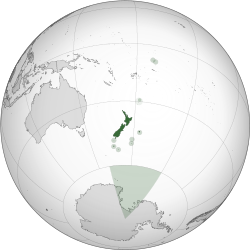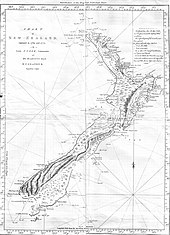New Zealand
| New Zealand
Aotearoa (Māori)
|
|
|---|---|

Location of New Zealand within the Realm of New Zealand
|
|
| Capital | Wellington 41°17′S 174°27′E |
| Largest city | Auckland |
| Official languages | |
| Ethnic groups (2013) | |
| Demonym | New Zealander Kiwi (informal) |
| Government | Unitary parliamentary constitutional monarchy |
|
• Monarch
|
Elizabeth II |
| Dame Patsy Reddy | |
| Jacinda Ardern | |
| Dame Sian Elias | |
| Legislature | Parliament (House of Representatives) |
| Stages of Independence from the United Kingdom | |
| 7 May 1856 | |
|
• Dominion
|
26 September 1907 |
| 25 November 1947 | |
| Area | |
|
• Total
|
268,021 km2 (103,483 sq mi) (75th) |
|
• Water (%)
|
1.6[n 4] |
| Population | |
|
• 2017 estimate
|
4,876,050[6] (120th) |
|
• 2013 census
|
4,242,048 |
|
• Density
|
17.9/km2 (46.4/sq mi) (203rd) |
| GDP (PPP) | 2018 estimate |
|
• Total
|
$195.1 billion[7] |
|
• Per capita
|
$39,959[7] |
| GDP (nominal) | 2018 estimate |
|
• Total
|
$215.1 billion[7] |
|
• Per capita
|
$44,069[7] |
| Gini (2014) | 33.0[8] medium |
| HDI (2015) | very high · 13th |
| Currency | New Zealand dollar ($) (NZD) |
| Time zone | NZST[n 5] (UTC+12) |
|
• Summer (DST)
|
NZDT[n 6] (UTC+13) |
| Date format | dd/mm/yyyy |
| Drives on the | left |
| Calling code | +64 |
| ISO 3166 code | NZ |
| Internet TLD | .nz |
Sometime between 1250 and 1300, Polynesians settled in the islands that later were named New Zealand and developed a distinctive Māori culture. In 1642, Dutch explorer Abel Tasman became the first European to sight New Zealand. In 1840, representatives of Britain and Māori chiefs signed the Treaty of Waitangi, which declared British sovereignty over the islands. In 1841 New Zealand became a colony within the British Empire and in 1907 it became a Dominion; it gained full independence in 1947, but the British monarch remained the head of state. Today, the majority of New Zealand's population of 4.7 million is of European descent; the indigenous Māori are the largest minority, followed by Asians and Pacific Islanders. Reflecting this, New Zealand's culture is mainly derived from Māori and early British settlers, with recent broadening arising from increased immigration. The official languages are English, Māori and New Zealand Sign Language, with English being dominant.
New Zealand is a developed country and ranks highly in international comparisons of national performance, such as health, education, economic freedom and quality of life. Since the 1980s, New Zealand has transformed from an agrarian, regulated economy to a diverse market economy. Nationally, legislative authority is vested in an elected, unicameral Parliament, while executive political power is exercised by the Cabinet, led by the Prime Minister, who is currently Jacinda Ardern. Queen Elizabeth II is the country's head of state and is represented by a governor-general, currently Dame Patsy Reddy. In addition, New Zealand is organised into 11 regional councils and 67 territorial authorities for local government purposes. The Realm of New Zealand also includes Tokelau (a dependent territory); the Cook Islands and Niue (self-governing states in free association with New Zealand); and the Ross Dependency, which is New Zealand's territorial claim in Antarctica. New Zealand is a member of the United Nations, Commonwealth of Nations, ANZUS, Organisation for Economic Co-operation and Development, Pacific Islands Forum, ASEAN Plus mechanism, and Asia-Pacific Economic Cooperation.
History
The Māori people are most likely descended from people who emigrated from Taiwan to Melanesia and then travelled east through to the Society Islands. After a pause of 70 to 265 years, a new wave of exploration led to the discovery and settlement of New Zealand.[21]
An early map of Australasia during the Golden Age of Dutch exploration (c. 1590s – c. 1720s). Based on a chart by Joan Blaeu, c. 1644.
Map of the New Zealand coastline as Cook charted it on his first visit in 1769–70. The track of the Endeavour is also shown.
The Waitangi sheet from the Treaty of Waitangi
A meeting of European and Māori inhabitants of Hawke's Bay Province. Engraving, 1863.
In 1891 the Liberal Party, led by John Ballance,[50] came to power as the first organised political party.[51] The Liberal Government, later led by Richard Seddon,[52] passed many important social and economic measures. In 1893 New Zealand was the first nation in the world to grant all women the right to vote[51] and in 1894 pioneered the adoption of compulsory arbitration between employers and unions.[53]
In 1907, at the request of the New Zealand Parliament, King Edward VII proclaimed New Zealand a Dominion within the British Empire, reflecting its self-governing status.[54] In 1947 the country adopted the Statute of Westminster, confirming that the British Parliament could no longer legislate for New Zealand without the consent of New Zealand.[46]
Early in the 20th century, New Zealand was involved in world affairs, fighting in the First and Second World Wars[55] and suffering through the Great Depression.[56] The depression led to the election of the First Labour Government and the establishment of a comprehensive welfare state and a protectionist economy.[57] New Zealand experienced increasing prosperity following the Second World War[58] and Māori began to leave their traditional rural life and move to the cities in search of work.[59] A Māori protest movement developed, which criticised Eurocentrism and worked for greater recognition of Māori culture and of the Treaty of Waitangi.[60] In 1975, a Waitangi Tribunal was set up to investigate alleged breaches of the Treaty, and it was enabled to investigate historic grievances in 1985.[40] The government has negotiated settlements of these grievances with many iwi,[61] although Māori claims to the foreshore and seabed have proved controversial in the 2000s








No comments:
Post a Comment